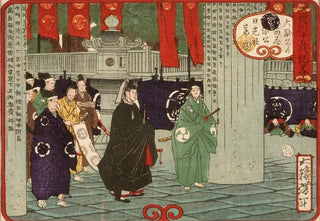Art print | Tokugawa Tsunayoshi visiting the Nikkō shrine for the thirtieth anniversary of Iemitsu's death - Tsukioka Yoshitoshi


View from behind

Frame (optional)
Tokugawa Tsunayoshi visiting the Nikkō shrine for the thirtieth anniversary of Iemitsu's death: a vibrant homage to Shinto tradition.
In this artwork, the painter captures a solemn moment where Tokugawa Tsunayoshi, dressed in rich traditional garments, visits the Nikkō shrine. The vivid colors and meticulous details of the costumes contrast with the serenity of the surrounding landscape. The technique of silk painting, typical of the Edo period, gives the scene a majestic yet contemplative atmosphere. The majestic trees and architectural structures of the shrine rise gracefully, creating a perfect setting for this memorable ceremony. Every brushstroke seems to tell a story, inviting the viewer to feel the depth of this historic moment.
Tokugawa Tsunayoshi: a ruler at the heart of Edo art.
Tokugawa Tsunayoshi, the fifth shogun of the Tokugawa dynasty, reigned from 1680 to 1709 and is often associated with a period of peace and prosperity in Japan. His reign was marked by an increased interest in arts and culture, fostering the development of painting, literature, and theater. Influenced by Buddhism and Shintoism, Tsunayoshi sought to promote spiritual values through his actions. The artwork "Tokugawa Tsunayoshi visiting the Nikkō shrine for the thirtieth anniversary of Iemitsu's death" perfectly illustrates this commitment to tradition and spirituality, while highlighting the importance of rituals in Japanese society of the time.
A decorative acquisition with multiple assets.
The art print of "Tokugawa Tsunayoshi visiting the Nikkō shrine for the thirtieth anniversary of Iemitsu's death" is an ideal choice to enhance your interior decor. Whether in a living room, office, or bedroom, this canvas will add a touch of elegance and culture to your space. Its faithful print quality and vibrant colors guarantee undeniable aesthetic appeal. By incorporating this artwork into your decor, you are not only beautifying your environment but also offering a window into Japanese history and tradition, sparking curiosity and admiration among your guests.

Matte finish

View from behind

Frame (optional)
Tokugawa Tsunayoshi visiting the Nikkō shrine for the thirtieth anniversary of Iemitsu's death: a vibrant homage to Shinto tradition.
In this artwork, the painter captures a solemn moment where Tokugawa Tsunayoshi, dressed in rich traditional garments, visits the Nikkō shrine. The vivid colors and meticulous details of the costumes contrast with the serenity of the surrounding landscape. The technique of silk painting, typical of the Edo period, gives the scene a majestic yet contemplative atmosphere. The majestic trees and architectural structures of the shrine rise gracefully, creating a perfect setting for this memorable ceremony. Every brushstroke seems to tell a story, inviting the viewer to feel the depth of this historic moment.
Tokugawa Tsunayoshi: a ruler at the heart of Edo art.
Tokugawa Tsunayoshi, the fifth shogun of the Tokugawa dynasty, reigned from 1680 to 1709 and is often associated with a period of peace and prosperity in Japan. His reign was marked by an increased interest in arts and culture, fostering the development of painting, literature, and theater. Influenced by Buddhism and Shintoism, Tsunayoshi sought to promote spiritual values through his actions. The artwork "Tokugawa Tsunayoshi visiting the Nikkō shrine for the thirtieth anniversary of Iemitsu's death" perfectly illustrates this commitment to tradition and spirituality, while highlighting the importance of rituals in Japanese society of the time.
A decorative acquisition with multiple assets.
The art print of "Tokugawa Tsunayoshi visiting the Nikkō shrine for the thirtieth anniversary of Iemitsu's death" is an ideal choice to enhance your interior decor. Whether in a living room, office, or bedroom, this canvas will add a touch of elegance and culture to your space. Its faithful print quality and vibrant colors guarantee undeniable aesthetic appeal. By incorporating this artwork into your decor, you are not only beautifying your environment but also offering a window into Japanese history and tradition, sparking curiosity and admiration among your guests.






